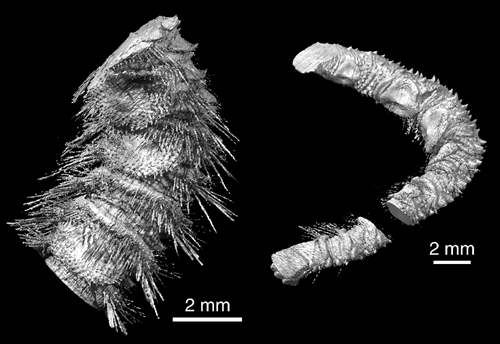
| Palaeos |  |
Aculifera |
| Mollusca | Heloplacidae |
| Page Back | Unit Up | Clade Up: Mollusca / Aculifera |
Page Next |
| Unit Back: Mollusca | Clade Down: Caudofoveata, Solenogastres, Polyplacophora and perhaps Conchifera |
References | Unit Next |
|
Abbreviated Dendrogram
MOLLUSCA |--ACULIFERA | |==Mattheviidae | |--Phthipodochiton | `--+==Heloplacidae (Aplacophora) | | |--Acaenoplax | | |--Heloplax | | `--+--Solenogastres | | `--Caudofoveata | `--Polyplacophora `--CONCHIFERA |
Overview |
Taxa on This Page
 |
Heloplacidae Cherns, 2004 : Acaenoplax, Arctoplax, Enetoplax, Heloplax
Range: Silurian
Phylogeny: basal Mollusca = paraphyletic Aculifera : Heloplacidae + (Caudofoveata + Solenogastres) + (Phthipodochiton + Polyplacophora) + Septemochiton + Conchifera
Comments: Plated aplacophora, best representated by Acaenoplax (Cherns 2004, Sutton et al 2004) Wikipedia. Correspond to the Paleoloricates i part. They seem to have been common and diverse during the Silurian. The granular dorsal ornament is similar to that of extant chitons, and hence possibly linked with sensory cells (aesthetes). Three Silurian baltic (Gotland) genera share an unusual, holoperipheral growth style similar to that of plated aplacophorans such as Acaenoplax, and coexisted with paleoloricate chitons in shallow inshore carbonate shelf environments (Cherns 2007). Preliminary cladistic analysis shows the Heloplacids form a sister group to other Early Palaeozoic paleoloricates (Cherns 2007) although they can just as easily and perthaps more likely forma paraphyletic ancetsral assemblage (Sigwart & Sutton 2007, Vinther et al 2011).
Range: Silurian
Phylogeny: Paraphyletic Heloplacidae
Comments: worm-like mollusc, preserved in three dimensions in the Silurian Herefordshire lagerstatte; its disarticulated valves are known from other Silurian deposits.[1] It is very bizarre by modern standards; it bears serially repeated units, and has spines. It probably falls somewhere between the aplacophorans and polyplacophora; its valves were composed of aragonite (Sutton et al 2004) Wikipedia
 |
Acaenoplax hayae Sutton et al, 2001
Horizon: Herefordshire Lagerstatte (Wenlock, Silurian).
Phylogeny: Paraphyletic Heloplacidae
Comments: Acaenoplax is a worm-shaped mollusc a couple of centimetres long and half a centimetre wide, and comprises serially repeated units with seven or eight shells, and rings of 'spines'. The organism resembles a bristled worm, but bears a number of shells on its upper surface. The first shell is cap-like, whereas the others are saddle-shaped. The rearmost shell is almost rectangular, whereas the others are more circular, with spines on the rear surface of the third to sixth shells. The originally-aragonitic shells do not overlap. There are eighteen rows of spines projecting from ridges in the body surface, which encircle the body except for its bottom surface, which presumably bore a molluscan foot. Its straight gut was preserved in phosphate. (Sutton et al 2001, Sutton et al 2004) Wikipedia
Some of Acaenoplax's characters are reminiscent of the polychaete worms, and the character combinations do not place it obviously in the stem of any modern mollusc group. It was it was originally interpreted as a polychaete, and (Steiner & Salvini-Plawen 2001 argue that it is an annelid rather than a mollusc, although this interpretation was refuted (Sutton et al 2001b), and the consensus opinion now is that Acaenoplax is an aculiferan mollusc (Cherns 2007, Sigwart & Sutton 2007, Vinther et al 2011, etc). MAK120607
| Page Back | Unit Home | Page Top | Page Next |
Page MAK120612 Creative Commons Attribution